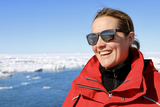
Antarctic Legacy Archive
Using the nitrogen isotopes to understand the past and present polar ocean and atmosphere: a plan for research capacity development and student training
- ALSA Home
- →
- Documents
- →
- Research Events
- →
- View Item
JavaScript is disabled for your browser. Some features of this site may not work without it.
| dc.contributor.author | Fawcett, S.E. | |
| dc.contributor.author | Altieri, K.E. | |
| dc.coverage.spatial | Polar Ocean | |
| dc.coverage.spatial | Southern Ocean | |
| dc.coverage.spatial | Antarctic | |
| dc.date.accessioned | 2021-03-05T15:52:38Z | |
| dc.date.available | 2021-03-05T15:52:38Z | |
| dc.date.created | 18-Aug | |
| dc.date.issued | 18-Aug | |
| dc.identifier.uri | http://hdl.handle.net/123456789/28345 | |
| dc.description.abstract | Studies of the nitrogen (N. cycle are essential for understanding the coupled ocean-atmosphere system. While not the primary limiting nutrient in much of the Southern Ocean, N nonetheless exerts a dominant control on Antarctic productivity and CO2 drawdown as it is required universally by phytoplankton. Additionally, N emissions from the surface ocean to the atmosphere impact climate through new particle formation and by neutralizing atmospheric acidity. N has two stable isotopes, the natural abundance distributions of which provide an integrated view of biogeochemical and physical processes that are highly variable in time and space. The denitrifier-isotope ratio mass spectrometry (IRMS. method can be used to measure the N isotopes of almost all N species, revolutionising N cycle studies since its development in 2001. It is now the global standard for N isotope research, facilitating the analysis of samples 100-1000 times smaller than conventional techniques allow and permitting the simultaneous analysis of the oxygen (O. isotopes of nitrate. Despite international expectations that most N cycle questions will be addressed using the denitrifier-IRMS method, it has yet to be implemented in any African laboratory. Here, we describe our efforts to develop it in South Africa and discuss its utility for Antarctic science. For example, nitrate N and O isotopes can be used to quantify seasonal nitrate drawdown (i.e., net community production. and disentangle overlapping N cycle processes that complicate estimates of CO2 removal; nutritional preferences of important phytoplankton taxa can be deduced from the N isotopes of organic biomass; the hypothesis that more complete Southern Ocean macronutrient consumption drove the ice-age atmospheric CO2 decline can be tested using the N isotopes of sedimentary microfossils; the N and O isotopes of atmospheric nitrate can be used to distinguish NOx sources and preindustrial oxidant chemistry, while atmospheric ammonium isotopes can be used to trace marine ammonia emissions and their impact on new particle formation. - Abstract as displayed in the - Abstract booklet. The presentation on the day may differ from the - Abstract. | en_ZA |
| dc.description.sponsorship | Sponsored by the the Department of Science and Innovation(DSI) through National Research Foundation (NRF) - South Africa | en_ZA |
| dc.description.statementofresponsibility | Antarctic Legacy of South Africa | en_ZA |
| dc.format | en_ZA | |
| dc.language | English | en_ZA |
| dc.language.iso | en_ZA | en_ZA |
| dc.publisher | South African National Antarctic Programme (SANAP. | en_ZA |
| dc.relation | SANAP Symposium 2018 | en_ZA |
| dc.rights | Copyright | en_ZA |
| dc.rights | Copyright | en_ZA |
| dc.subject | Research | en_ZA |
| dc.subject | Science | en_ZA |
| dc.subject | Meetings | en_ZA |
| dc.subject | Symposium | en_ZA |
| dc.subject | SANAP Symposium 2018 | en_ZA |
| dc.subject | Nitrogen | en_ZA |
| dc.subject | Oxygen | en_ZA |
| dc.subject | Isotopes | en_ZA |
| dc.subject | CO2 | en_ZA |
| dc.subject | Phytoplankton | en_ZA |
| dc.subject | Polar Ocean | en_ZA |
| dc.subject | Southern Ocean | en_ZA |
| dc.subject | Antarctic | en_ZA |
| dc.subject | Ocean Science | en_ZA |
| dc.subject | Earth Systems | en_ZA |
| dc.title | Using the nitrogen isotopes to understand the past and present polar ocean and atmosphere: a plan for research capacity development and student training | en_ZA |
| dc.type | Abstracts | en_ZA |
| dc.rights.holder | Antarctic Legacy of South Africa | en_ZA |
| dc.rights.holder | Fawcett, S.E. | en_ZA |
| dc.rights.holder | Altieri, K.E. | en_ZA |
| iso19115.mdconstraints.uselimitation | This item and the content of this website are subject to copyright protection. Reproduction of the content, or any part of it, other than for research, academic or non-commercial use is prohibited without prior consent from the copyright holder. | en_ZA |
| iso19115.mddistributor.distributorcontact | South African National Antarctic Programme -SANAP. | en_ZA |
| iso19115.mdformat.name | en_ZA | |
| iso19115.mdidentification.deliverypoint | Antarctic Legacy of South Africa, Faculty of Science, Private Bag X1, Matieland. Stellenbosch. South Africa. | en_ZA |
| iso19115.mdidentification.electronicmailaddress | antarcticlegacy@sun.ac.za | en_ZA |
| iso19115.mdidentification.organizationname | University of Cape Town | en_ZA |
Files in this item
This item appears in the following Collection(s)
-
Research Events [502]
Material directly related to official scientific and research events

